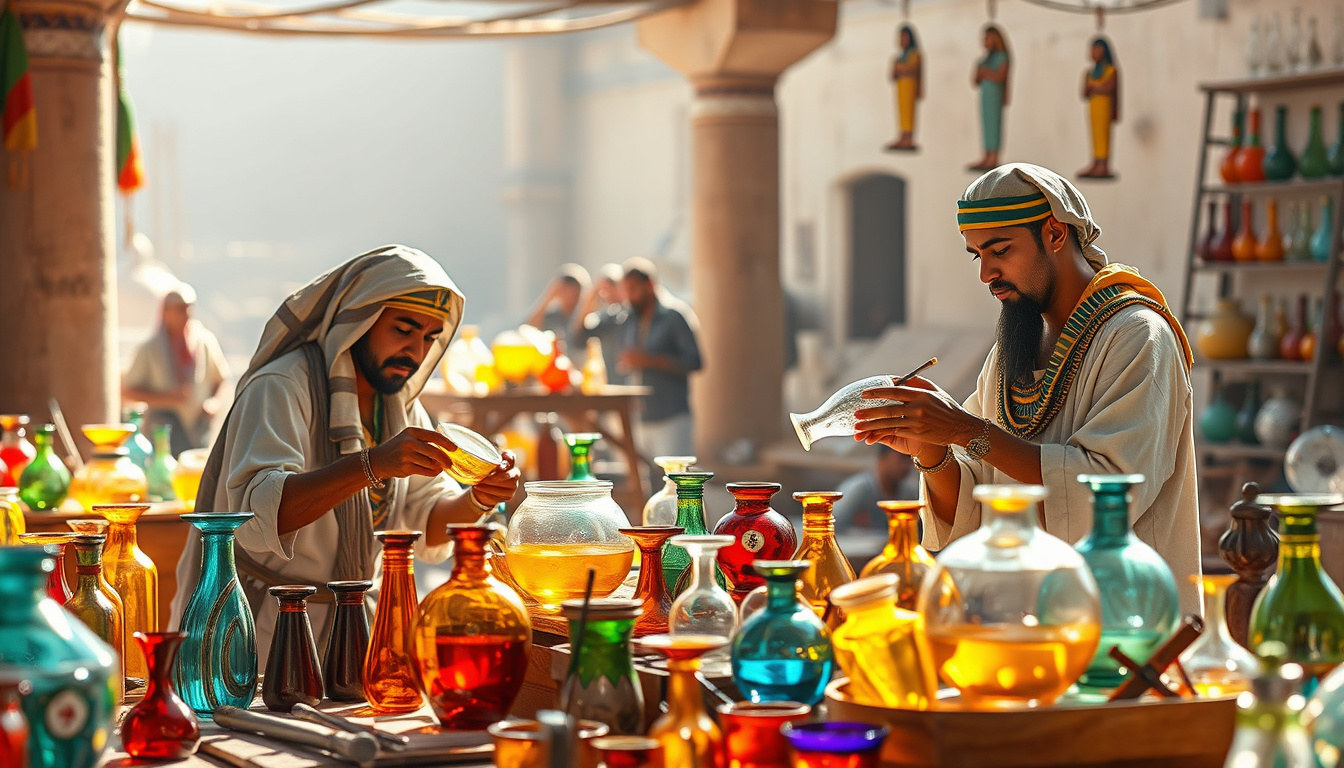Egypt is often admired for its rich tapestry of history, with ancient wonders like the Pyramids standing as a testament to its remarkable past.
Yet, beyond these colossal monuments lies another marvel of antiquity: the art of ancient Egyptian glassmaking.
This intricate craft, dating back thousands of years, fused artistry with practicality, influencing cultures far beyond the Nile.
In this exploration, we will unveil the secrets of ancient Egyptian glassmaking, delving into its history, raw materials, innovative techniques, and enduring legacy.
Whether you are a history enthusiast or simply curious about this stunning craftsmanship, join us as we uncover the fascinating world of ancient Egypt’s glass artisans.


Forming and Shaping Methods of Ancient Egyptian Glass
## Forming and Shaping Methods of Ancient Egyptian Glass
Ancient Egyptian glassmaking is a fascinating intersection of art and technology, deeply reflective of the era’s sophisticated craftsmanship.
The methods employed by ancient artisans illustrate not just their technical skills but also their understanding of materials and aesthetics.
One of the primary techniques used in ancient Egyptian glassmaking was core-forming.
This method involved shaping a core made of clay or a similar substance and then layering molten glass around it.
Once cooled, the core could be removed, leaving behind beautifully formed glass objects, such as vessels and decorative pieces.
This technique allowed artisans to create intricate designs and patterns, which often incorporated vibrant colors and varied textures that appealed to the aesthetic sensibilities of the time.
Another essential method was casting, where molten glass was poured into molds to create specific forms.
This approach not only expedited production but also allowed artisans to make multiple identical pieces, which was useful for producing popular items like beads and amulets.
The casting method also enabled the introduction of detailed designs engraved within the molds, showcasing the artistic flair of ancient Egyptian culture.
Glassblowing came later but introduced a new dimension to ancient Egyptian glassmaking.
While it is primarily associated with the Roman period, its origins can trace back to the experimentation of earlier cultures, including the Egyptians.
By manipulating gathered glass into various shapes, artisans could produce an array of stunning pieces, enhancing both functionality and beauty.
The artistry of ancient Egyptian glassmaking is further enriched by the use of color, commonly achieved through the addition of metallic oxides.
Such techniques resulted in striking hues that were often meant to symbolize various themes or deities in Egyptian mythology.
These colors were not merely for beauty; they also had deeper meanings, reflecting the spirituality that pervaded ancient Egyptian society.
As you explore ancient Egyptian glassmaking, it becomes evident that these techniques were crucial in establishing Egypt’s reputation as a center for exquisite glass artistry.
The artifacts created during this period are not only historically significant but also provide insight into the daily lives, religious practices, and trade of ancient Egyptians.
Coloring and Decoration in Ancient Egyptian Glass Art
## Coloring and Decoration in Ancient Egyptian Glass Art
Ancient Egyptian glassmaking is a fascinating aspect of the civilization’s rich artistic heritage, showcasing sophisticated techniques and a vibrant aesthetic that captivated both locals and visitors alike.
The ancient Egyptians mastered the craft of glassmaking by blending minerals with silica, allowing them to produce a spectrum of hues and forms.
This craft flourished particularly during the New Kingdom (1550-1070 BC), where artisans created stunning glass vessels, beads, and intricate decorative items.
One of the most notable features of ancient Egyptian glass art is the vibrant coloring achieved through various additives.
Copper, for instance, was used to create striking blue and green shades, reminiscent of the lush Nile River and the sky above.
Iron, on the other hand, produced shades of green, while manganese can be found in pieces with purple tones.
These colors not only reflected the beauty of the natural world but also held symbolic significance, often believed to carry meanings of fertility, protection, and the afterlife.
Decorative techniques also played a critical role in ancient Egyptian glassmaking.
Artisans mastered methods such as mold blowing and core-formed techniques to create unique shapes and patterns.
Many pieces were adorned with intricate designs, featuring hieroglyphs, floral motifs, and geometric patterns, which spoke to the cultural and religious significance of the items created.
For instance, glass vessels were often used in burial offerings, believed to provide for the deceased in the afterlife, thus showcasing the importance of decoration in both function and symbolism.
The legacy of ancient Egyptian glassmaking continues to inspire modern artisans and historians alike, proving that the colors and decorations from this remarkable era possess a timeless allure.
 August 2025
August 2025

